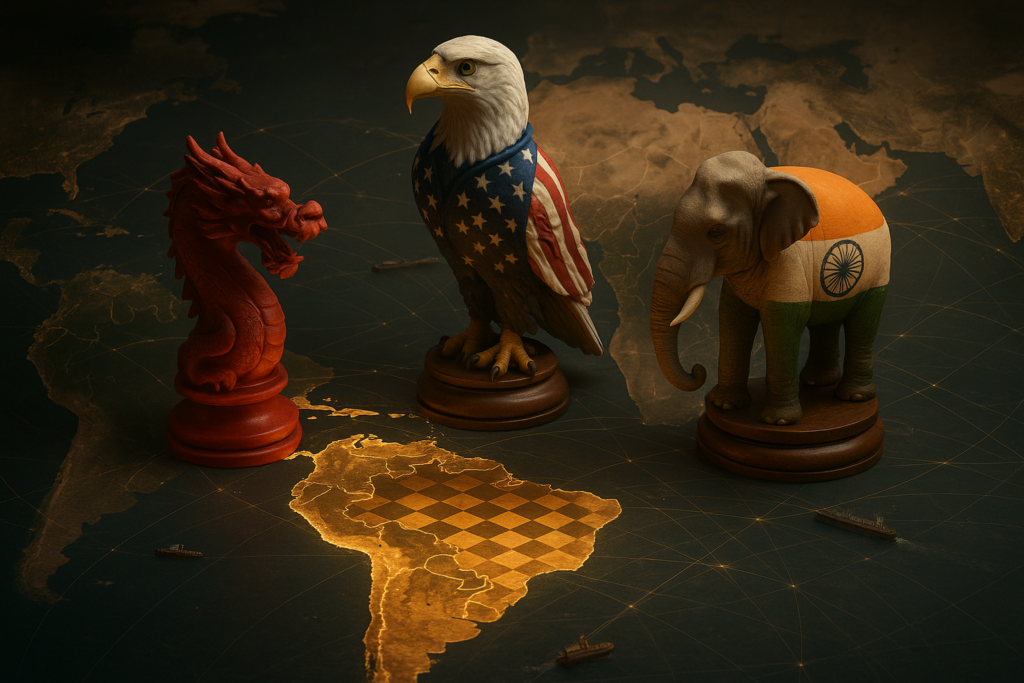
- Through its Belt and Road Initiative (BRI), China offered large-scale investments and loans for infrastructure projects, notably without imposing political or economic conditions, unlike Western lenders.
- Latin America possesses highly diversified natural resources such as oil, copper, lithium, soy, and rare earth minerals, all essential to the U.S. economy and the global green energy transition.
- China has entered a region that the U.S. long regarded as its “backyard,” and China now refers to Latin America as its “front yard.”
- Prime Minister Narendra Modi’s visit to Brazil marks a significant step in deepening India’s engagement with Latin America, reflecting New Delhi’s growing focus on the Global South.
Introduction
The Latin American region has a long history of colonisation by European powers, which primarily focused on extracting its rich minerals and natural resources. After gaining independence, Latin American countries experimented with various political and economic models to foster growth and stability. They tried nationalist governments, dictatorships, and both right-wing and left-wing regimes — reflecting a long history of political diversification and economic experimentation, as highlighted by economists like H. Cardoso and Paul R for growth and development.
The region is naturally endowed with abundant minerals, forests, and critical energy resources, yet it remains underdeveloped. This underdevelopment has deep historical roots. Initially, the region was exploited by colonisers, and after independence, during the Cold War, the United States heavily intervened in its affairs. The U.S. viewed Latin America through the lens of its rivalry with the Soviet Union, directly involving itself in the region’s politics — even orchestrating several coups to contain the spread of communism.
Through this intervention, the U.S. promoted a capitalist model that positioned Latin America primarily as a supplier of raw materials to the developed world. This gave rise to a form of neo-colonialism, where resource dependency, poverty, and unemployment persisted. The “resource curse” became the region’s reality, preventing sustainable long-term growth and leaving it dependent on the West for development.
After the Cold War, when containing communism was no longer a central concern, the International Monetary Fund (IMF) and the World Bank took over as key external actors. Through their lending programs, they imposed a “one-size-fits-all” capitalist model and provided loans in exchange for structural economic changes. This approach led many countries into economic traps, culminating in what became known as the “Lost Decade.”
By the 2000s, the United States began to lose interest in Latin America, treating it as its “backyard” and paying little attention to its development needs. However, the dynamics began to change with the entry of China as a major player in the region.
The region is naturally endowed with abundant minerals, forests, and critical energy resources, yet it remains underdeveloped.
China’s Expanding Role in Latin America
Through its Belt and Road Initiative (BRI), China offered large-scale investments and loans for infrastructure projects — notably without imposing political or economic conditions, unlike Western lenders. China is deepening ties with LAC not only to expand trade but also to challenge U.S. dominance. Its engagement extends to political and strategic goals, evident in the gradual shift of diplomatic recognition away from Taiwan. Of the 33 LAC countries, seven initially maintained formal relations with Taiwan, though Honduras ended its relationship in 2023. Since extending the BRI to the region in 2017, over 21 LAC countries have signed BRI agreements, gaining access to infrastructure financing while reinforcing China’s global presence.
China’s engagement has brought a new sense of hope and recognition to Latin America. Although no investment comes without costs, China has provided the region with an alternative development partner and a fairer chance to integrate into the global economy.
Why Is Latin America Important?
Geography and Resources: Latin America possesses highly diversified natural resources such as oil, copper, lithium, soy, and rare earth minerals, all essential to the U.S. economy and the global green energy transition. The region holds 57% of the world’s lithium reserves, 37% of its copper, nearly one-fifth of global oil, and almost one-third of the planet’s freshwater and primary forests (Myers et al., 2021).
Strategic Position: Latin America forms a crucial part of the Western Hemisphere, encompassing both South and North America. As John J. Mearsheimer explains in The Tragedy of Great Power Politics, the best way for a state to survive in an anarchic international system is to become the sole regional hegemon. To emerge as a global power, a country must first ensure stability and dominance in its immediate neighbourhood. This logic explains why the United States maintains military bases across the world and influences global politics — it faces no significant threat in its own region (Nincic, 2003).
During the Cold War, Latin America became a critical area where the U.S. sought to prevent the spread of communism, culminating in events like the Cuban Missile Crisis of 1961–62. Today, the rival power is not Russia, but China.
Shifting Trade Dynamics: The Latin American and Caribbean (LAC) region has become economically important as trade increasingly shifts from LAC–U.S. to LAC–China, alarming the United States. Trump alleged that LAC countries were being used as a backdoor for Chinese products entering the U.S. market. A clear example is the China–Brazil relationship, which strengthened economically and politically. Bilateral trade surged from just over $3 billion in 2001 to $44 billion in 2010, reaching $100 billion by 2019. Recently, Presidents Lula and Xi elevated their ties to a “China–Brazil community with a shared future for a more just world and a more sustainable planet,” reflecting China’s growing influence in the region.
China has entered a region that the U.S. long regarded as its “backyard,” and China now refers to Latin America as its “front yard.” The political landscape of Latin America is no longer the same as during the Cold War. Countries in the region are increasingly disillusioned with the West due to unfulfilled promises and historical U.S. interventions, and they no longer view the U.S. as a friendly or trustworthy partner.
Current Scenario Under Trump
Under U.S. President Donald Trump, Latin America experienced worsening relations due to tariffs, protectionist policies, and an anti-immigration stance. For example, in Brazil, Washington imposed a 50% tariff and openly supported former right-wing President Jair Bolsonaro against Lula da Silva. In Panama, Trump criticised Chinese investments and even suggested bringing the Panama Canal under U.S. control.
These actions reflect a broader pattern of distrust between Latin American nations and the U.S., rooted in historical events such as U.S.-backed coups in Guatemala, Cuba, and Brazil. The Trump administration’s approach deepened this trust deficit across the region.
The U.S. considers the Western Hemisphere its geopolitical backyard, rooted in the Monroe Doctrine (1823).
China’s Role in the Region
China’s engagement spans mining, energy, infrastructure, manufacturing, and trade. Chinese companies invest heavily in lithium in Mexico, copper and gold in Peru, and oil in Venezuela, as well as natural gas projects in Peru and Ecuador. China continues infrastructure work in Guyana, including the $260 million Demerara Harbour Bridge, and has deepened diplomatic ties through BRICS. Trade initiatives include new shipping routes, export permits for Brazilian coffee firms, and shifting soybean imports from the U.S. to South America. Chinese e-commerce giants like Temu, SheIn, and AliExpress are rapidly expanding, while infrastructure projects include railways in Chile, a $600 million credit line to Ecuador, and investments in Brazil’s automotive sector.
While LAC receives less than 1% of total BRI investment, China’s presence is strategically significant, reinforcing South-South cooperation, multipolarity, and influence in global governance. Projects like the Bi-Oceanic Railway, connecting Brazil’s Atlantic coast with Chile’s Pacific ports, illustrate China’s strategic integration of the region into its global connectivity agenda (Vila Seoane, 2023).
U.S.–China Competition in the Western Hemisphere
The U.S. considers the Western Hemisphere its geopolitical backyard, rooted in the Monroe Doctrine (1823). LAC’s proximity makes it a first line of defence for U.S. national security. American policymakers resist foreign military presence in the region.
U.S. officials, including Senator Bernie Moreno, Ambassador Kevin Cabrera, and Admiral Alvin Holsey, have expressed concerns about China exporting its authoritarian model, extracting resources, and building dual-use infrastructure. These warnings highlight U.S.–China competition, although China continues expanding its influence through investment and diplomacy.
India in the Region
Prime Minister Narendra Modi’s visit to Brazil marks a significant step in deepening India’s engagement with Latin America, reflecting New Delhi’s growing focus on the Global South. The visit strengthens India-Brazil strategic ties and builds on outreach across Argentina, Uruguay, Bolivia, and Cuba on the sidelines of the BRICS Summit in Rio de Janeiro. Visits to Trinidad and Tobago and Guyana underscore India’s sustained partnership with CARICOM.
Bilateral agreements with Argentina, Uruguay, and Cuba aim to boost cooperation in trade, technology, and climate action. Regional leaders from Chile, Paraguay, and Mexico have also acknowledged India’s rising global influence and economic strength. As External Affairs Minister S. Jaishankar noted, India’s growing economy and innovation-driven transformation are bringing the country closer to Latin America than ever before.
As External Affairs Minister S. Jaishankar noted, India’s growing economy and innovation-driven transformation are bringing the country closer to Latin America than ever before.
Conclusion
Trump’s policies have dealt heavy blows to India, Brazil, and China, potentially accelerating closer coordination among BRICS members — an alliance he often viewed as anti-American. His tariffs could, in the short term, push these emerging economies to deepen cooperation in trade, investment, and currency usage, presenting a united front against U.S. economic pressure. However, the durability of this front remains uncertain. India may hesitate to align too closely under China’s influence, and Russia’s international isolation could constrain deeper integration.
Nonetheless, Latin America’s increasing strategic and economic importance, combined with China’s investments and India’s engagement, gives the region more options and negotiating power. The evolving dynamics signal a potential reshaping of global alliances and the emergence of a more multipolar world order in the years ahead.
References:
- https://www.newkerala.com/news/o/latin-america-no-longer-distant-pm-modi-builds-deeper-805
- https://www.cfr.org/article/china-latin-america-august-2025
- Nincic, M. (2003). The Tragedy of Great Power Politics. By John J. Mearsheimer. New York: WW Norton, 2001. 448p. $27.95 cloth. Perspectives on politics, 1(1), 232-233.
- China’s Growing Influence in Latin America | Council on Foreign Relations. (n.d.). Retrieved July 12, 2025, https://www.cfr.org/backgrounder/china-influence-latin-america-argentina-brazil venezuela-security-energy-bri
- https://www.reuters.com/markets/could-trump-tariffs-become-bric-building-blocks-2025-08-07/
- Vila Seoane, M. F. (2023). Mediated public diplomacy and securitisation theory: The US campaign against Chinese 5G in Brazil and Chile. International Relations, 00471178231205412. https://doi.org/10.1177/00471178231205412
Garima Sharma is a Master’s student in International Relations at Jawaharlal Nehru University. Her interests include public policy, international governance, geopolitics, defence, and security. Views expressed are the author’s own.
